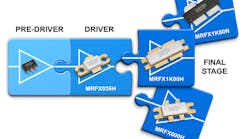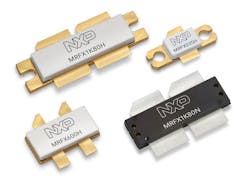65-V Transistors Aim to Shake Up the High-Power RF Arena
For NXP Semiconductors, high-power RF is undoubtedly a trademark—the company offers a wide range of RF power products for various applications. NXP has now reached a new milestone with the introduction of the MRFX Series high-power products based on the company’s 65-V LDMOS technology. The first product, the MRFX1K80H, was released in 2017. NXP recently expanded the MRFX Series by introducing three new devices: the MRFX1K80N, MRFX600H, and MRFX035H (see figure).
65-V LDMOS technology represents a significant change for high-power applications. “On the consumer and industrial side, 50-V LDMOS technology has been dominant for the last decade,” says Franck Nicholls, product line manager at NXP. “Last year, we introduced a higher-voltage solution, which brings ease of use to our customers.”
So, what exactly are the benefits of NXP’s 65-V LDMOS technology? The company points out five specific advantages. For one, higher voltage enables higher power density, which helps reduce the number of transistors to combine when building power amplifiers (PAs). Another advantage of the 65-V devices is that the output power can be increased while still retaining a reasonable output impedance. As a result, 50-Ω matching is easier to achieve.
Shown are the MRFX1K80H, MRFX1K80N, MRFX600H, and MRFX035H devices.
A third benefit is what NXP calls “design reuse,” which means that MRFX Series devices can fit onto existing printed circuit boards (PCBs) designed for 50-V devices—with little to no retuning required. Reduced current levels and a wider safety margin due to a higher breakdown voltage are the two remaining benefits.
Looking at the performance of the three new products, the MRFX1K80N is an 1,800-W transistor that covers a frequency range of 1.8 to 400 MHz. It’s the plastic-package version of the previously released MRFX1K80H. The MRFX600H is a 600-W transistor that also operates from 1.8 to 400 MHz. Finally, the MRFX035H is a 35-W transistor that covers a frequency range of 1.8 to 512 MHz.
With the MRFX Series, NXP is targeting various markets. Among them are industrial-scientific-medical (ISM) applications, such as laser generation, plasma generation, particle accelerators, and more. Broadcast applications represent another market that NXP is aiming for. Aerospace and defense applications stand to benefit from the MRFX Series as well.
NXP also revealed that it has developed many reference circuits for the MRFX1K80H transistor over the last year, each covering various frequency bands. Lastly, the company also announced a partnership with ABB, which is developing a power supply unit (PSU) that can power the MRFX Series devices.
For more information, click here.


